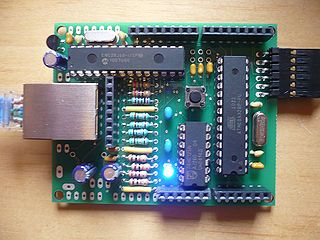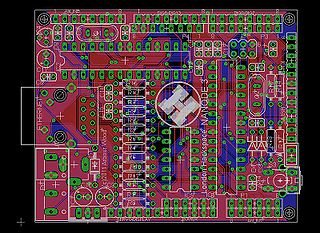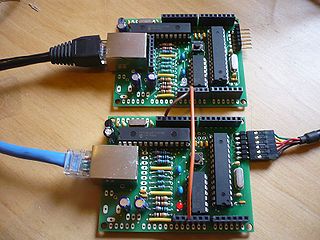Difference between revisions of "Project:Nanode"
| Line 35: | Line 35: | ||
==London Hackspace Custom Nanode== | ==London Hackspace Custom Nanode== | ||
| + | |||
| + | Here's a first draft of the proposed custom Nanode for the Hackspace. The Big H logo is a bit wonky, but we should be able to correct that with a bitmap import. | ||
| + | |||
| + | This new board offers several improvements over the frst prototype. | ||
| + | |||
| + | The reset switch is vertically mounted on the edge of the board - so it can be pressed even though there may be a shield fitted. | ||
| + | The LED is visible with a shield fitted. | ||
| + | The local serial bus is now a 4 way screw terminal block for very easy hooking up with telephone cable. | ||
| + | Auto reset now added from serial interface | ||
| + | Virtual USB Added. [http://www.obdev.at/products/vusb/index.html Vusb] USB is done in firmware negating the need for a £15 FTDI cable - cool. | ||
| + | |||
[[File:Hackspace_nanode.jpg|320px|right|thumb|A Customised Nanode for the Hackspace]] | [[File:Hackspace_nanode.jpg|320px|right|thumb|A Customised Nanode for the Hackspace]] | ||
Revision as of 23:28, 1 April 2011
New page for Ken's new project 'Nanode' (formerly 'Ethernet Arduino') For full background and earlier work please see Ethernet Arduino
Open Source Collaborative Projects
The Nanode is possibly the first open source collaborative hardware design project at the London Hackspace- conceived, designed, manufactured and coded by Hackspace members - for Hackspace members. As an exercise in the design and building of a simple but useful microcontroller product, Nanode will introduce minimum cost web connectivity.
About the Nanode - Some Background
The Nanode is a low cost entry device aimed at Internet Connectivity projects. It has been designed to be built easily for under £20 - so that it will appeal to those on a tight budget.
It is based on the Arduino environment so will be familiar to many. It will accept Arduino shields, if necessary with longer pins to improve clearance between the Magjack connector and the underside of the shield.
It consists of a small PCB which has the ATmega328 microcontroller, some glue logic, the ENC28J60 ethernet controller and a Magjack ethernet connector. The board only uses through-hole and DIL conventional components - so that it can be easily assembled by anyone who has basic solderng skills.
It makes an ideal project for a teaching workshop on web connectivity, and as such will appeal to Hackspaces for advanced Arduino workshops.
Yes - but what does it do?
Nanode uses a Ethernet code library developed by Andrew Lindsay. Andrew has provided examples for a Twitter Client (using supertweet.net), a Pachube Publisher and Pachube Subscriber. Andrew has also developed code to allow DNS Client queries and sending UDP packet to a local network.
Nanode can be used as a micro web-server for simple home automation and control, be used to build web connected sensor networks and many other web connected applications.
For those wanting to tinker with M2M applications, two Nanodes can communicate data or commands via a web data service such as Pachube.
Another unique feature is that several Nanodes can be connected together on a multidrop serial bus and used for distributed control tasks, such as energy montoring or home automation. The wired network supplies communications and power and can be made from low cost 4 core telephone cable. Individual Nanodes can communicate via this network back to an ethernet connected "Master" unit. With RS485 driver ICs, the Nanode can be adapted as a DMX lighting controller, MIDI network or other serial control system.
By removing the ethernet controller and Magjack, it becomes a very low cost Arduino "work-alike".
Nanode is an Open Source Project.
London Hackspace Custom Nanode
Here's a first draft of the proposed custom Nanode for the Hackspace. The Big H logo is a bit wonky, but we should be able to correct that with a bitmap import.
This new board offers several improvements over the frst prototype.
The reset switch is vertically mounted on the edge of the board - so it can be pressed even though there may be a shield fitted. The LED is visible with a shield fitted. The local serial bus is now a 4 way screw terminal block for very easy hooking up with telephone cable. Auto reset now added from serial interface Virtual USB Added. Vusb USB is done in firmware negating the need for a £15 FTDI cable - cool.
Test Drive a Nanode at the Pachube Hackathon April 8th/9th
Ken I will be hosting a Nanode build session at the space on Saturday 2nd April from 10am.
There will be the opportunity to build up 2 pairs of Nanodes and get them talkng to each other via Pachube. There will be 4 Nanodes available for the Pachube Hackathon, with priority given to LHS members. Even if you are not at the event, but want to play with the Nanode at the space, during that event, let me know.
Board waiting list
Elliot has started a Pledge Page so that we can pool component purchasing and get the best price. The cost is £18 per Nanode which is a full kit of parts including pcb.
I would like to do a special London Hackspace branded version with a custom LHS logo on the screenprint. If anyone with EagleCAD experience would like to assist with this artwork please get in touch. As soon as we have this artwork and a minor board update, we can order the next batch. --Ken
Now that we have reached 30 boards, we should consider collecting some money and getting a batch of pcbs ordered from Spirit Electronics. I think that 2 square feet of board will just about fit 40 boards. --Ken
The First Prototypes
Here are the two boards each connected to a network port. The orange and brown wires between the boards is so that they can share the 5V power from the FTDI cable.
The upper board is the Publisher (Putter) and the lower board is the Subscriber (Getter). Every few seconds the Putter sends a new packet of data up to Pachube feed 8729, and at regular intervals the Getter subscribes to this feed to retrieve the data. In this case the data is a simple comma separated list of 6 arguments, which could be six readings from the ADCs on the Putter device, or a numerical command to which the Getter will respond.
Building a Nanode
The complete step by step build sequence can be found on my blog
Parts List
All parts are readily available. I recommend Cool Components in South London for several of the key items. Interested parties should try to pool component purchasing to access volume discounts.
* 1 ATmega328 microcontroller (with Arduino bootloader) - CoolComponents £5.00 (£2.81 without bootloader) * 1 ENC28J60 ethernet controller - CoolComponents 1.99 * 1 Magjack - CoolComponents £1.99
The remaining parts were found to be considerably cheaper from Rapid Electronics giving a kit cost of £18 if parts are purchased in 10 off. This includes all parts, pcb, shipping and VAT.
* 1 74AHC125 quad buffer 174-9617 * 1 16MHz crystal 161-1761 * 1 25MHz crystal 161-1783 * 4 22pF ceramic capacitors 114-1760 * 8 100nF ceramic capacitors 121-6444 * 2 10nF ceramic capacitors 121-6435 * 3 10uF electrolytic capacitors 945-1056 * 1 7805 5V regulator 156-4483 * 1 78L33 3V3 regulator 146-7768 * 1 2K resistor 934-1480 * 4 51ohm 1% resistors 934-3342 * 3 270 ohm resistors 933-9353 * 3 10K resistors 933-9060 * 1 tact switch 181-3689 * 2 8 way 0.1" SIL Sockets * 2 6 way 0.1" SIL Sockets * 1 6 way 0.1" right angle header * 1 2.1mm dc jack socket * 1 1N4001 diode * 1 3mm LED * 2 32 pin 0.1" header strips (for optional I/O connectors).
You will also need:
* 1 Nanode pcb - available shortly to Hackspace members * 1 FTDI USB-serial cable - becoming a standard bit of kit for talking to microcontrollers. * or similar USB to serial converter such as Sparkfun/Cool Components * 1 CAT5 network cable to connect to router
Current Build Files
The first prototype Nanode 2j had a couple of minor layout bugs, these have been corrected in 2l. The EagleCAD pcb files have been uploaded to Thingiverse as a starting point, but potential users should read the bug-list on the schematic page.
I've now corrected the pcb errors and made some improvements. The Version 3c files are here on Thingiverse
1. Fixed the incorrect connections on the Magjack
2. Moved the reset switch to edge of board and allow for a vertical switch which can be pressed even if shield is fitted.
3. Moved the LED to board edge so that you can see it
4. The local comms bus and power now comes out on a 4 pin screw terminal for easy-peezy connection
5. Added auto reset capacitor C17 on pin 6 of FTDI connector
6. Added pull-up resistor to /RXEN so that it defaults to FTDI connection
7. Removed surplus connectors
8. Added a H as a place keeper for the proper Hackspace Logo
9. Added text "London Hackspace NANODE 3" and Arbour Wood (c)2011 (My Firm).
10. Improved position of 3V3 decoupling capacitors on ENC28J60
11. Analogue input connector J12 now has GND pin
12. Implemented Virtual USB with connector P7 on end of the pcb - saving cost of FTDI cable!!
14. I think that these would be so cool on blue pcb board with white Hackspace "H" Logo
Nanode: Applications and Brainstorming
This section is for all potential applications and wild ideas of what can be done with the Nanode.
As a simple example, a Nanode could read up to 6 analogue sensors, connected to its ADC inputs - such as temperature sensing thermistors or LM35 thermometer ICs. These temperature sensors are located in different rooms of the house, or outside, or on the hot water tank. Between them they give an indication of the state of the home heating. The temperature readings are published up to a Pachube feed, where they can be accessed by other devices. A Nanode subscribing to the feed reads the temperature data as a CSV string, strips out the numerical data and acts on its content. For example controlling a user display, operating relays which control the boiler for heating or hot water as it is required.
The CSV format which Pachube uses is flexible enough to cope with many types of data, or even direct numerical commands. A string of comma separated, numerical commands passed up to Pachube could be simply interpreted by any subscribing Nanodes to perform a specific action. The first number could be the address of the Nanode which you want to command, for example the one which controls the boiler relay.
Openenergymonitor have developed some very low cost Arduino based devices to read electricity and gas meters. One of these will shortly be released as an Arduino shield and could use the Nanode as its connection to the net.
The other main application of the Nanode is in Master/Slave wired networks. Several Nanodes are connected to a wired serial bus and distributed about the environment where they run sensing or control tasks - such as a home automation system or DMX lighting control system. Each slave can be addressed individually by a Master controller, which then connects via its ethernet connection to the web.
Slaves could store sensor readings in RAM (limited to 2K on the '328) and periodically be polled by the Master device to connect to the serial bus and upload its data. Data could be recorded straight off the serial bus using the Openlog serial data logger concept from Sparkfun Electronics. The Openlog code runs nicely on an Arduino fitted with a SDcard shield, so could be run on the Master Nanode. The Master could act as a SDcard based file server or storage to the serially connected slaves.
Questions & Answers & Feedback
If you have any queries - please put them here.
Is the local bandwidth between two nanodes enough to create an ethernet bridge in software? -- Answer to myself: the multidrop bus is in the range of 9600 baud.
The ATmega328 is not limited to 9600 baud serial. If the distance between nodes is short then 115,200baud may be possible. You could also connect nodes together with I2C or SPI. Ken
Can non-members join the PCB batch?
Yes - but note that we are currently only offering a full kit consisting of pcb and all components.
> Thanks. And the same deal in joining in with the full parts order? (£18.00+donation). Do we just add names to the list above?
We have been looking at the practicalities of providing a full kit, and think this is the best way to proceed, at this time.
Bare boards may be available at a later date, but for now the £18 kit is the only option being offered. A small donation to the Hackspace from non-members would be appreciated. Ken


